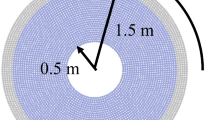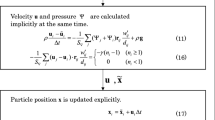Abstract
The Moving Particle Semi-implicit (MPS) method is a Lagrangian particle method based on the prediction–correction calculation of the velocity field and the Helmhotz–Hodge decomposition. Initially the predicted velocity is calculated with the viscous and external forces terms and then corrected by the gradient of the pressure which is obtained by the solution of the Poisson Pressure’s equation. The MPS was developed for non-compressible bodies and it is adequate for free surface problems. However, when used to simulate fluid structure interaction problems, like ship resistance, the original formulation of the method can not accurately compute the pressure distribution over the bodies. This paper proposes a modified MPS method for modelling immerse bodies in an free surface flow. It was found that small variations in the source term of the Poisson Pressure’s equation can destabilise simulations. Therefore, a reformulation of the Poisson pressure equation was developed. The results show that the proposed variation produced numerical stabilisation. The free surface particles behave in a good agreement with experimental observations. Also, although pressure fluctuations were still present, satisfactory results were obtained when comparing the drag coefficient with those reported values in the literature.








Similar content being viewed by others
References
Caboussat, A., Picasso, M., Rappaz, J.: Numerical simulation of free surface incompressible liquid flows surrounded by compressible gas. J. Comput. Phys. 203(2), 626–649 (2005)
Donea, J., Huerta, A.: Finite Element Methods for Flow Problems. Wiley, New York (2003)
Ferziger, J.H., Perić, M.: Computational Methods for Fluid Dynamics, 3rd edn. Springer, Berlin (2002)
García, M., Duque, J., Boulanger, P., Figueroa, P.: Computational steering of CFD simulations using a grid computing environment. Int. J. Interact. Des. Manuf. 9(3), 235–245 (2015). doi:10.1007/s12008-014-0236-1
Gingold, R.A., Monaghan, J.J.: Smoothed particle hydrodynamics–theory and application to non-spherical stars. Mon. Not. R. Astron. Soc. 181, 375–389 (1977)
Goswami, P., Schlegel, P., Solenthaler, B., Pajarola, R.: Interactive SPH simulation and rendering on the GPU. In: Proceedings of the 2010 ACM SIGGRAPH/Eurographics Symposium on Computer Animation, pp. 55–64. Eurographics Association (2010)
Hirt, C.W., Nichols, B.D.: Volume of fluid (VOF) method for the dynamics of free boundaries. J. Comput. Phys. 39(1), 201–225 (1981)
Hwang, S., Khayyer, A., Gotoh, H., Park, J.: Development of a fully lagrangian MPS-base coupled method for simulation of fluid–structure interaction problems. J. Fluids Struct. 50, 497–511 (2014)
Khayyer, A., Gotoh, H.: Development of CMPS method for accurate water-surface tracking in breaking waves. Coast. Eng. J. 50(2), 179–207 (2008)
Khayyer, A., Gotoh, H.: Modified moving particle semi-implicit methods for the prediction of 2d wave impact pressure. Coast. Eng. 56(4), 419–440 (2009)
Khayyer, A., Gotoh, H.: A high order Laplacian model for enhancement and stabilization of pressure calculation by MPS method. Appl. Ocean Res. 32, 124–131 (2010)
Khayyer, A., Gotoh, H.: Enhancement of stability and accuracy of the moving particle semi-implicit method. J. Comput. Phys. 230(8), 3093–3118 (2011)
Khayyer, A., Gotoh, H.: A 3D higher order Laplacian model for enhancement and stabilization of pressure calculation in 3D MPS-based simulations. Appl. Ocean Res. 37, 120–126 (2012)
Khayyer, A., Gotoh, H.: Enhancement of performance and stability of MPS mesh-free particle method for multiphase flows characterized by high density ratios. J. Comput. Phys. 242, 211–233 (2013)
Kondo, M., Koshizuka, S.: Improvement of stability in moving particle semi-implicit method. Int. J. Numer. Methods Fluids 65, 638–654 (2011)
Koshizuka, S., Ikeda, H., Oka, Y.: Numerical analysis of fragmentation mechanisms in vapor explosions. Nucl. Eng. Des. 189(1–3), 423–433 (1999). doi:10.1016/S0029-5493(98)00270-2. http://www.sciencedirect.com/science/article/pii/S0029549398002702
Koshizuka, S., Nobe, A., Oka, Y.: Numerical analysis of breaking waves using the moving particle semi-implicit method. Int. J. Numer. Methods Fluids 26(7), 751–769 (1998)
Koshizuka, S., Oka, Y.: Moving particle semi-implicit method or fragmentation of incomprssible fluid. Nucl. Sci. Eng. 123, 421–434 (1996)
Lee, B., Park, J., Kim, M., Hwang, S.: Step by step improvement of MPS method in simulating violent free-surface motions and impact-loads. Comput. Methods Appl. Mech. Eng. 200(9), 1113–1125 (2011)
Li, S., Liu, W.: Meshfree and particle methods and their applications. Appl. Mech. Rev. 55(1), 1–34 (2002)
Li, S., Liu, W.K.: Meshfree Particle Methods. Springer, Berlin (2004)
Lucy, L.: A numerical approach to the testing of the fission hypothesis. Astron. J. 82(12), 1013–1024 (1977)
Maronnier, V., Picasso, M., Rappaz, J.: Numerical simulation of free surface flows. J. Comput. Phys. 155(2), 439–455 (1999)
Martin, J.C., Moyce, W.J.: Part IV. An experimental study of the collapse of liquid columns on a rigid horizontal plane. Philos. Trans. R. Soc. Lond. A: Math. Phys. Eng. Sci. 244(882), 312–324 (1952). doi:10.1098/rsta.1952.0006
Monaghan, J.J.: Simulating free surface flows with SPH. J. Comput. Phys. 110, 399–406 (1994)
Müller, M., Charypar, D., Gross, M.: Particle-based fluid simulation for interactive applications. In: Proceedings of the 2003 ACM SIGGRAPH/Eurographics Symposium on Computer Animation, pp. 154–159. Eurographics Association (2003)
Price, D.J.: Splash: an interactive visualisation tool for smoothed particle hydrodynamics simulations. Publ. Astron. Soc. Aust. 24(03), 159–173 (2007)
Shakibaeinia, A., Jin, Y.C.: A weakly compressible MPS method for modeling of open-boundary free-surface flow. Int. J. Numer. Methods Fluids 63(10), 1208–1232 (2010)
Shibata, K., Koshizuka, S.: Numerical analysis of shipping water impact on a deck using a particle method. Ocean Eng. 34, 585–593 (2007)
Shibata, K., Koshizuka, S., Tanizawa, K.: Three-dimensional numerical analysis of shipping water onto a moving ship using a particle method. J. Mar. Sci. Technol. 14, 214–227 (2009)
Sueyoshi, M., Kashiwagi, M., Naito, S.: Numerical simulation of wave-induced nonlinear motions of a two dimensional floating body by the moving particle semi-implicit method. J. Mar. Sci. Technol. 13, 85–94 (2008)
Tamai, T., Koshizuka, S.: Least squares moving particle semi-implicit method. Comput. Part. Mech. 1(3), 277–305 (2014)
Tanaka, M., Masunaga, T.: Stabilization and smoothing pressure in MPS method by quasi-compressibility. J. Comput. Phys. 229(11), 4279–4290 (2010)
Tsubota, K.I., Wada, S., Kamada, H., Kitagawa, Y., Lima, R., Yamaguchi, T.: A particle method for blood flow simulation: application to flowing red blood cells and platelets. J. Earth Simul. 5, 2–7 (2006)
Venugopal, V., Varyanib, K.S., Barltrop, N.D.: Wave force coefficients for horizontally submerged rectangular cylinders. Ocean Eng. 30, 1669–1704 (2006)
Wang, Q., Zheng, Y., Chen, C., Tadahiro, F., Chiba, N.: Efficient rendering of breaking waves using MPS method. J. Zhejiang Univ. Sci. A 7(6), 1018–1025 (2006). doi:10.1631/jzus.2006.A1018
Wenisch, P., Treeck, C.V., Borrmann, A., Rank, E., Wenisch, O.: Computational steering on distributed systems: indoor comfort simulations as a case study of interactive CFD on supercomputers. Int. J. Parallel Emerg. Distrib. Syst. 22(4), 275–291 (2007)
Zhang, F., Hu, L., Wu, J., Shen, X.: A SPH-based method for interactive fluids simulation on the multi-GPU. In: Proceedings of the 10th International Conference on Virtual Reality Continuum and its Applications in Industry, pp. 423–426. ACM (2011)
Author information
Authors and Affiliations
Corresponding author
Rights and permissions
About this article
Cite this article
Perez, C.A., Garcia, M.J. Flow behaviour over a 2D body using the moving particle semi-implicit method with free surface stabilisation. Int J Interact Des Manuf 11, 633–640 (2017). https://doi.org/10.1007/s12008-016-0338-z
Received:
Accepted:
Published:
Issue Date:
DOI: https://doi.org/10.1007/s12008-016-0338-z




